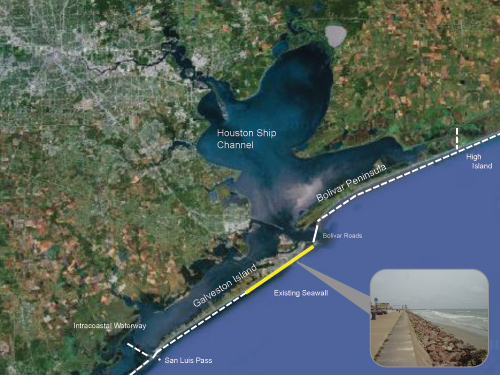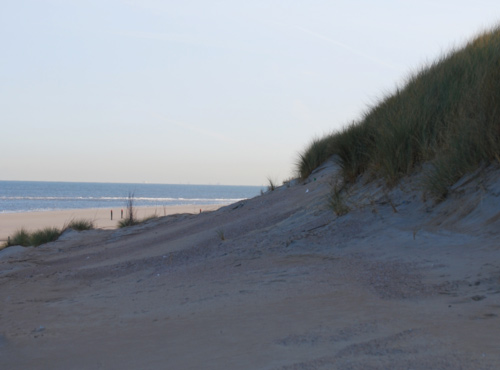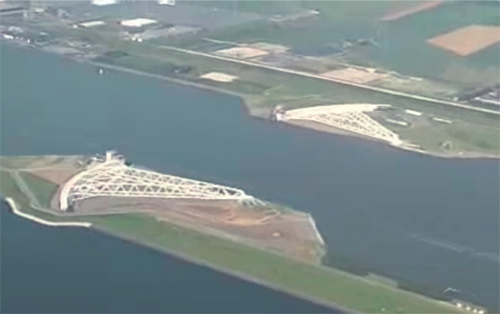
‘Ike Dike’ proposes to keep flood waters at bay along Texas Gulf Coast

Jennifer Ferguson
The Signal
In wake of the devastation caused by Hurricane Ike in 2008, many plans have been presented for implementing a means of protection for the Texas Gulf Coast.
While Galveston serves as the front line of attack for hurricanes in the Gulf, the Galveston Bay and surrounding areas are just as vulnerable to the flooding and devastation that threatens the coast.
One solution was created by William Merrell, professor of oceanography at the Texas A&M University in Galveston. Merrell began working on a concept after witnessing Hurricane Ike’s devastation firsthand. His idea, deemed the “Ike Dike,” is an extension of the current Seawall to include more of the west end of the island, paired with a similar structure along the Bolivar Peninsula to protect the immediate coast.
As for protecting the rest of the Texas Gulf Coast, the project includes plans to construct colossal flood barriers at the entry of Galveston Bay. These gate-like structures, which were modeled from the Delta Works project in the Netherlands, would allow for the natural flow of bay waters during calm weather but could be closed in a matter of 30 minutes.
“The Dutch developed gate technology that allows for navigation and water exchange while the gates are open but protects from storm surge when the gates are closed,” Merrell explained. “Having worked with the Dutch for a number of years and being familiar with their best practices and technologies, I worked on how to apply them to the Galveston Bay region. The result is the ‘Ike Dike’ concept.”
Merrell said the project would cost the city close to $3 billion to build the necessary structures. Since 1900, Galveston has experienced six direct, major hurricane hits with damages costing at least $34.7 billion and with as many as 12,222 lives lost.
“The liability of this happening, as we saw with Ike, is 10 times the cost of [the Ike Dike],” Galveston Mayor Joseph Jaworski said. “The cost of going forward doing nothing is untenable.”
Galveston is not the only county that would benefit from such a structure. A 2007 study by The Perryman Group reports that the 14-county area that makes up the Gulf Coast is populated with approximately 5.6 million residents, accounts for about 30 percent of the business economy and 26 percent of the total income of the entire state of Texas. Additionally, the area generates almost one-fourth of the entire country’s petroleum products, making this region essential, not only to the Texas economy, but that of the nation, as well.
Nonetheless, the only thing protecting this region is a 10-mile-long, 17-foot-tall cement barrier, the Galveston Seawall. The Seawall, which was completed in 1904 in response to the Great Storm of 1900, was designed to defend the island from violent storm surges.
While the Seawall has proven successful in its initial purpose, the Galveston surface has sunk as much as 10 feet in certain areas. It does not offer any protection to the island’s expanding west end nor the Bolivar Peninsula, nor does it provide any defense from flooding in the Galveston Bay and those surrounding areas.
“At the time of the 1900 Storm, the west end had cattle grazing and, I believe, a lace linen factory with a railroad line, and very few residents,” said Jerry Mohn, president of the West Galveston Island Property Owners Association and advocate of the Ike Dike. “[There was] no economic advantage to build the Seawall to the west end.”
A major hurricane hits the Texas Gulf Coast approximately every 15 – 20 years, creating a demand for up-to-date defense systems.
Marie Robb, president and CEO of Coastal Solutions, was a resident of Bermuda Beach during Hurricane Ike. Robb lost her entire home to the hurricane.
“It was the closest thing to a war setting that I think I will ever see in my life,” Robb recalls of returning to the island. “I remember thinking, ‘This is insane; why would we ever let this happen again? If in 1906 we could build a Seawall, why can we not build a fortified dune?’”
Robb, unaware of the Dutch program, borrowed a pencil from the reception desk of her hotel room. She then sketched a concept that was eventually passed on to Merrell. Merrell applied his previous knowledge to the concept, and the Ike Dike was born.
While originally received as a great solution to an ongoing issue, the Ike Dike has lost its momentum in recent months.
The Gulf Coast Community Protection and Recovery District is a six-county public cooperation that was created to examine surge protection on the upper Gulf Coast.
The cooperation, made up of Brazoria, Chambers, Galveston, Harris, Jefferson and Orange county judges, is expected to launch studies based on the Ike Dike and other storm surge concepts. Nonetheless, the review process is expected to be lengthy.
“Right now it will take years,” Mohn said. “There are no funds for the project, only a concept that we believe is viable because the Dutch have been so successful with surge protection systems.”
With every major hurricane, residents of Galveston and the surrounding areas are left to pick up the pieces and go on with their lives.
“Now I think the public can get involved by at least demanding some sort of engineering study for a levee, or some sort of revetment,” Jaworski said. “However, doing nothing is not an option.”
“Ike Dike” Phases Two & Three


